AI Pest Control: How Algorithms Detect Threats
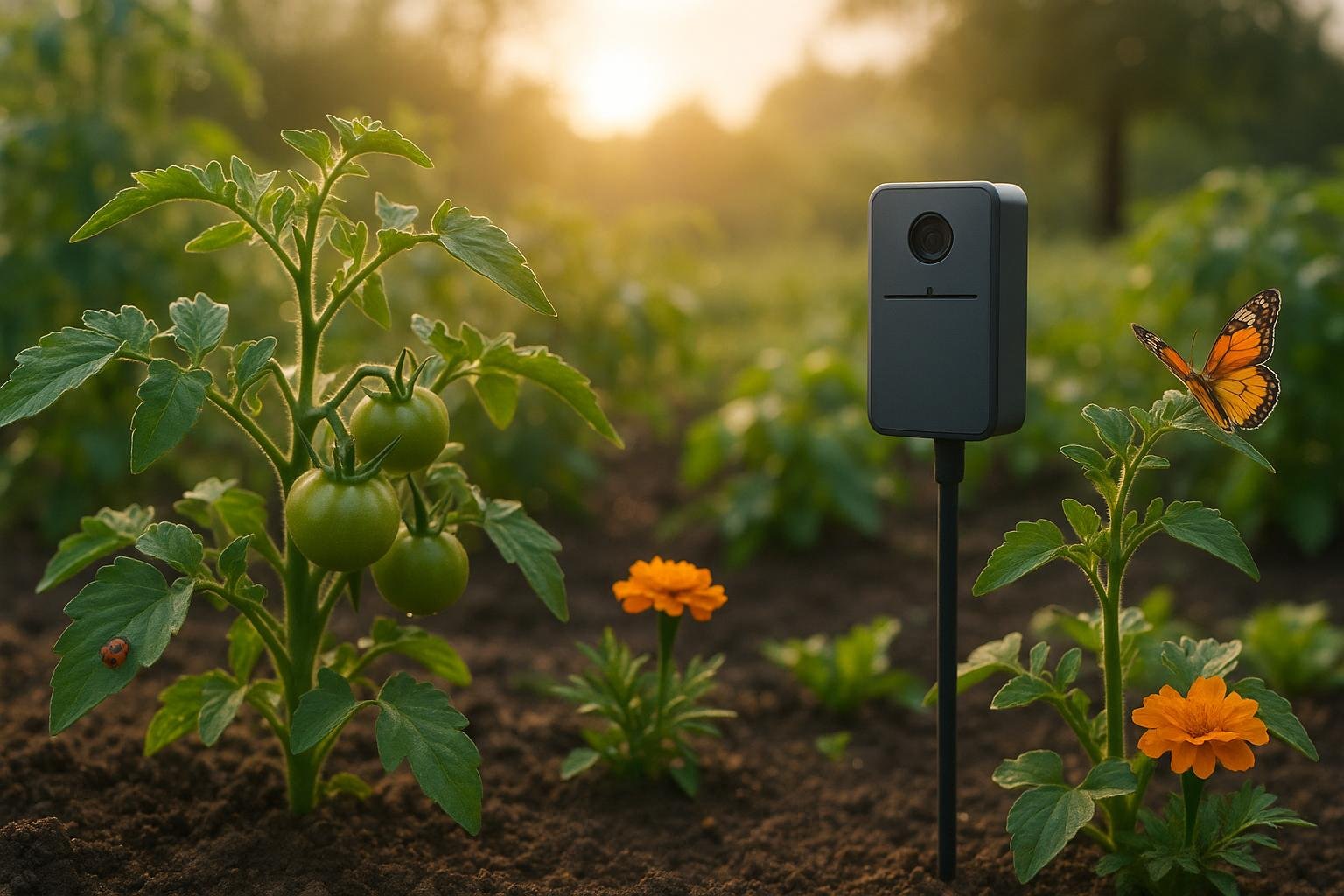
AI is revolutionizing pest control by offering smarter, faster, and more accurate ways to protect plants from pests and diseases. Instead of relying on harmful chemicals or time-consuming manual inspections, AI tools use advanced technologies like image recognition, machine learning, and sensors to detect and predict pest activity. Here’s what you need to know:
- Early Detection: AI systems identify pests and diseases before visible damage occurs, reducing crop losses by up to 40%.
- Eco-Friendly Solutions: Tools like smart sprayers cut chemical use by up to 90%, protecting beneficial insects and the environment.
- Cost Efficiency: AI-powered apps and devices save time and money with precise, targeted interventions.
- Accessibility for All: From farmers to home gardeners, AI tools are available via smartphones, drones, and IoT devices, offering expert-level diagnostics in seconds.
AI-powered pest control is transforming gardening into a proactive, data-driven process that reduces waste, saves resources, and promotes healthier plants. Whether you’re managing a backyard garden or a large farm, these tools make pest management simpler and more effective.
Using AI to Identify Plant Disease, Track Insect Infestations, and Improve Food Security

How AI Algorithms Detect Pests and Diseases
AI algorithms are reshaping pest detection by turning garden photos into detailed diagnoses of pests and diseases. These systems rely on advanced technologies to provide precise and reliable identification tools.
Core Technologies Behind AI Detection
AI pest detection is powered by machine learning, computer vision, and sensor data analysis - each playing a key role in identifying pests with precision.
- Machine learning processes data from cameras and sensors to identify pests and recommend treatments. These algorithms improve over time by learning from thousands of examples, refining their ability to recognize patterns.
- Computer vision handles image analysis, using data from cameras, drones, or smartphones to detect pests. It identifies subtle changes in leaf color, texture, or shape that might escape the human eye, breaking images into thousands of data points for detailed analysis.
- Sensor data analysis adds depth by interpreting signals from heat, movement, sound, and even chemical changes in plants under stress.
Take FarmSense as an example. Their FlightSensor uses optical sensors and machine learning to monitor insects in real time. The device creates light curtains in tunnels, analyzing shadows and movements to identify specific pests as they pass through.
Another example is Trapview by EFOS Ltd., which combines IoT-enabled traps, cameras, and sensors. Its AI algorithms analyze the collected data to track pest populations in orchards and vineyards. As CEO Matej Štefančič explains:
"We've built the biggest database of pictures of insects in the world, which allows us to really use modern AI-based computing vision most optimally."
These technologies work together to transform raw data into actionable insights for managing pests effectively.
The Detection Process: From Images to Results
When you upload a garden photo to an AI-powered pest detection system, the algorithm gets to work. It analyzes visual patterns that indicate pest damage or disease symptoms, focusing on discoloration, spots, or texture anomalies on plant surfaces. By differentiating between healthy and affected areas, it pinpoints potential problems.
AI systems rely on large, labeled image datasets containing thousands of examples of healthy plants, diseased plants, and those affected by pests. These datasets help the algorithms improve their accuracy over time. For instance:
- Tamil Nadu Agricultural University (TNAU) achieved 93.47% validation accuracy and 98.47% training accuracy in identifying fall armyworm in maize crops.
- An updated YOLOv5 model reached 96% accuracy in identifying pests like leaf miners, fruit flies, aphids, whiteflies, house flies, and thrips.
Cloud-based APIs make these tools accessible on everyday devices, allowing integration with smartphones, drones, and IoT sensors. This means professional-grade pest detection is now available in your pocket, enabling precise and timely interventions to protect plants.
Real-Time Monitoring and System Improvement
AI systems don’t stop at detection - they continuously improve. By processing new data, they adapt to changing garden conditions, becoming smarter with each use.
- AI-equipped drones and cameras capture high-resolution images across large areas, alerting gardeners to issues before visible damage occurs.
- Acoustic sensors add another layer by detecting sounds like insect wing beats or larvae chewing, providing early warnings of pest activity.
Mobile apps bring this technology to your fingertips. For example:
- Penn State University's PlantVillage app uses machine learning to identify pests and diseases from user-uploaded photos.
- The University of Georgia's PestID app specializes in insect identification through smartphone cameras.
- The FAO's PestNet app employs deep learning to diagnose both pests and plant diseases from user photos.
What makes these systems powerful is their ability to learn continuously. As Dylan Henryson, Market General Manager at FieldRoutes, explains:
"As AI systems generate historical data - and as their integrated datasets get bigger simultaneously - predictions become faster and more accurate."
This improvement depends on high-quality data and ongoing refinement. Human oversight remains critical for addressing false positives and negatives, ensuring AI works hand-in-hand with expert judgment.
One standout example is Semios, which partnered with Google to reduce a moth population by 1.5 billion insects. This effort led to a significant boost in almond production. It highlights how AI, when properly implemented and refined, can deliver tangible results.
Key Benefits of AI-Driven Pest Detection
AI-powered pest detection is transforming pest control by offering benefits that traditional methods simply can’t match. From improving timing and cutting costs to making advanced tools more accessible, this technology is helping everyone - from hobby gardeners to large-scale farmers - better manage pests.
Early Detection and Targeted Response
One standout feature of AI pest detection is its ability to catch issues before they spiral out of control. Unlike manual inspections, which often miss early signs, AI systems can identify subtle changes in plants and vegetation. They analyze patterns and detect abnormalities, alerting users to potential pest problems - often before visible symptoms appear - all while working nonstop, 24/7.
These systems boast impressive accuracy rates, with 80–90% for pest detection and 70–85% for diagnosing plant diseases. This level of precision allows gardeners and farmers to take targeted action, tackling specific threats without resorting to blanket pesticide applications. On top of that, AI tools use predictive models to forecast pest outbreaks, enabling proactive measures and cutting down on unnecessary pesticide use.
By providing this early warning, AI helps reduce costs and promotes eco-friendly practices.
Cost Efficiency and Reduced Environmental Impact
Catching pest problems early isn’t just about saving crops - it’s also about saving money and reducing harm to the environment. Pests are responsible for 20–40% of global crop losses, costing the world economy an estimated $290 billion annually. AI-driven solutions help mitigate these losses by enabling timely, precise interventions.
Take Blue River Technology’s smart sprayer as an example. This system uses image-based pattern recognition to distinguish crops like cotton and wheat from weeds. By targeting only the weeds, it cuts herbicide use by up to 90% compared to traditional sprayers - all while maintaining effectiveness. Additionally, AI systems operate around the clock, reducing the need for labor-intensive manual inspections. With less reliance on pesticides, these tools not only save money but also encourage sustainable gardening practices and reduce environmental damage.
Accessibility for All Gardeners
Another major advantage of AI pest detection is how it levels the playing field, making expert pest control tools available to everyone. With just a smartphone or computer, gardeners can access professional-grade diagnostics. These apps use machine learning and computer vision to analyze plant images, providing accurate diagnoses in seconds, anytime, anywhere. This eliminates the need for lengthy consultations or trying to describe symptoms over the phone.
| Benefit | Description |
|---|---|
| Rapid Detection | Instant results compared to days spent researching manually |
| Accuracy | Trained systems deliver up to 90%+ match rates |
| Accessibility | Available 24/7 via smartphones or computers |
| User Insight | Helps users develop better pest recognition skills |
| Eco-friendly | Reduces chemical use through early and precise detection |
These tools empower gardeners to take immediate action, reducing unnecessary treatments and preventing crop loss. Many apps also offer personalized care tips and location-specific advice, tailoring recommendations to the user’s environment. Some even allow users to confirm or correct the AI’s findings, creating a feedback loop that continuously improves the technology.
Virtual gardening assistants are another exciting development. These tools can provide expert advice and answer questions around the clock. For the best results, users are encouraged to take photos in natural light, capture multiple angles (both close-up and wide), and enable location services when available. These simple steps can further enhance the accuracy of AI diagnostics.
With its ease of use and practical benefits, AI pest detection is a game-changer for gardeners of all skill levels.
sbb-itb-4d6a8dd
🚀 Ready to Reinvent Your Garden?
Join thousands of homeowners who have transformed their gardens using our AI design tool. Upload one photo to explore endless possibilities.
Get your AI garden designs →Practical Applications of AI in Pest Management
AI in pest management goes beyond just identifying pests - it offers practical, real-time solutions tailored to your garden's specific needs. These systems integrate smoothly with existing gardening methods, making pest control smarter and more efficient.
Actionable Pest Control Recommendations
AI-powered gardening tools stand out for their ability to provide customized, location-specific pest control advice. By analyzing factors like local weather, soil conditions, plant types, and pest threats, these systems suggest precise interventions.
For example, smart sensors can monitor moisture levels and weather conditions, automatically adjusting watering schedules and alerting gardeners when conditions favor pest activity. Automated traps even capture pests and send notifications to your phone, enabling quick action. In agriculture, such as cotton farming, AI combined with pheromone traps has been highly effective in managing bollworms. This approach helps farmers determine the optimal timing and amount of pesticide application, reducing waste and boosting crop yields. Similarly, home gardeners can benefit from AI tools that recommend specific treatments based on the type and number of pests detected.
This continuous flow of real-time data creates a cycle of improvement, aligning perfectly with broader pest control strategies like Integrated Pest Management (IPM).
Integration with Integrated Pest Management (IPM)
AI tools fit seamlessly into IPM strategies, offering data-driven insights that enhance sustainable pest management practices. Predictive analytics, such as FarmSense's real-time sensor data, enable precise, targeted interventions. Smart cameras record high-definition footage of pest behavior, helping gardeners devise strategies that work in harmony with natural ecosystems. Additionally, tools like Trapview use pheromone traps combined with imaging technology to predict pest population trends in real time.
AIGardenPlanner's Role in Garden Health Management
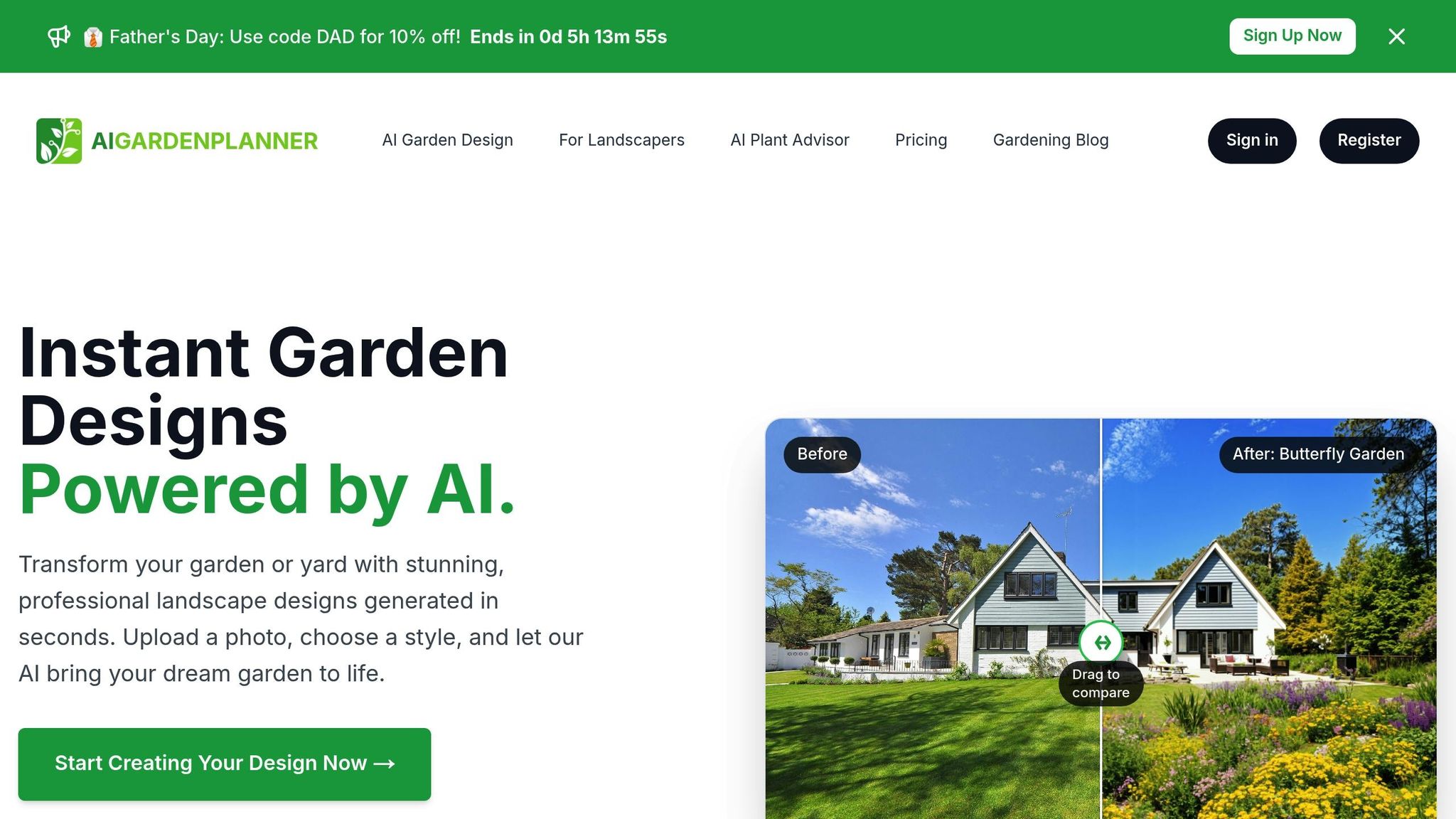
AIGardenPlanner takes AI-driven pest management a step further by embedding it into a holistic garden care system. By analyzing uploaded garden photos, the platform can detect early signs of pests or diseases and provide tailored recommendations based on your garden's location, climate, and conditions.
The platform’s AI Plant Advisor doesn’t just identify problems - it offers detailed care strategies. When pests are detected, it suggests treatments that align with your garden’s design and ecological balance, ensuring that pest control measures support both aesthetics and sustainability.
AIGardenPlanner also integrates pest management into overall garden planning. It can recommend companion planting strategies and suggest pest-resistant plant varieties. The platform generates detailed growing guides and maintenance schedules that include preventive pest management practices, helping gardeners stay one step ahead. For those using its professional-grade tools, the schedules include regular pest monitoring tailored to local conditions and specific plants. Additionally, its smartphone-controlled irrigation recommendations allow precise moisture control - discouraging pests that thrive in damp conditions while keeping plants healthy.
Comparing AI Pest Control Technologies
Selecting the right AI pest detection technology depends on your specific needs, budget, and technical expertise. Each method has its strengths and limitations, making them suitable for different gardening scenarios.
Comparison of Detection Methods
AI pest detection technologies can be broadly categorized into image recognition, sensor-based detection, and predictive analytics. Here’s a closer look at how these approaches differ and where they shine:
Image recognition systems rely on cameras to analyze visual data, identifying pests by their appearance or the damage they cause. For example, a convolutional neural network (CNN) model achieved an impressive 93% accuracy in detecting pests like Bactrocera oleae and Ceratitis capitata. Smartphone apps utilizing this technology offer rapid and accurate pest identification, making them highly accessible.
Sensor-based detection uses tools like acoustic, gas, and thermal sensors to identify pests through non-visual signals. These systems are known for their high accuracy, and some even integrate digital traps to monitor rodent activity and predict population trends. While effective, these systems often require proper setup and calibration.
Predictive analytics combines factors like pest life cycles, weather data, and historical trends to anticipate outbreaks before they happen. An example includes an AI-powered pheromone trap that photographs captured pests and provides real-time predictions on their spread. This forward-looking method allows gardeners to plan treatments weeks or months in advance.
| Detection Method | Detection Speed | Accuracy Range | Ease of Use | Cost Range | Ideal Use |
|---|---|---|---|---|---|
| Image Recognition | Real-time processing | 93–99% | High (smartphone apps) | Low to moderate | Identifying pests and visible symptoms |
| Sensor-Based Detection | Continuous monitoring | Up to 99.78% | Moderate (requires setup) | Moderate to high | Detecting hidden pests, early intervention |
| Predictive Analytics | Weeks to months ahead | Varies by model | Low to moderate | High | Large gardens, commercial-scale applications |
Each method is suited to specific conditions. Image recognition systems are an affordable choice for small gardens, while sensor-based and predictive analytics work better for medium to large gardens with higher budgets. For instance, image-based smart sprayers have enabled farmers to cut herbicide use by up to 90% compared to traditional methods.
However, environmental factors can influence performance. Image recognition systems may struggle with poor lighting or weather conditions, while sensor-based detection can be disrupted by wind or rain. Predictive analytics, though requiring significant data input, tends to remain reliable across varying weather patterns.
Pest damage causes an estimated 30–40% crop loss globally each year, according to the FAO. This highlights the importance of effective pest detection. For home gardeners, starting with image recognition apps offers a simple and immediate solution to familiarize themselves with AI-driven tools. Over time, incorporating sensor-based systems or predictive analytics can provide more comprehensive protection as pest challenges escalate.
Many gardeners find success by combining these technologies. For example, they might use smartphone apps for quick pest identification while deploying sensors for ongoing monitoring in vulnerable areas. The key is to choose a system that aligns with your garden’s size, budget, and specific needs. Together, these technologies emphasize the proactive role AI plays in modern gardening.
Conclusion
AI-powered pest control is changing the way gardeners manage plant health, turning what was once a reactive guessing game into a proactive, data-driven process that works for everyone - from novices to seasoned gardeners.
AI isn’t just about identifying pests. Take Blue River Technology’s smart sprayer, for example - it reduces herbicide use by up to 90% through precise, targeted applications. Similarly, Semios’s collaboration with Google helped cut moth populations by an astounding 1.5 billion, proving that AI can deliver eco-friendly solutions at scale.
On a smaller scale, AI-powered apps are bringing these advancements to home gardeners. With just a photo of an affected plant, these tools can identify pests or diseases and offer instant treatment suggestions. This makes expert-level advice accessible to anyone, empowering beginners to make confident, informed decisions about their gardens.
AI also helps optimize resources like water and treatments, promoting sustainable gardening practices. For instance, cotton farmers using AI-driven pheromone traps effectively manage bollworm infestations without over-spraying, leading to better yields and less waste.
Beyond pest control, AI is enhancing overall garden management. Tools like AIGardenPlanner simplify the entire process - from designing a garden tailored to local climate and soil conditions to offering personalized plant recommendations. These tools help gardeners create pest-resistant environments from the start, complete with detailed growing guides and maintenance schedules. By integrating AI into every step, gardeners can address potential issues before they arise, creating a more balanced and efficient approach to plant care.
While AI automates and fine-tunes pest management, human intuition still plays a vital role. Combining technology with personal expertise - whether for a backyard garden or a sprawling landscape - offers unmatched precision, efficiency, and care for the environment. The key is finding the right mix of AI tools to align with your gardening goals.
FAQs
How is AI pest control more environmentally friendly than traditional methods?
AI-powered pest control offers a greener approach by leveraging advanced algorithms to identify pests and diseases with pinpoint accuracy. This means treatments can target specific problem areas, significantly cutting down on the use of chemicals. As a result, the impact on beneficial insects, wildlife, and water sources is minimized.
With its data-driven approach, AI ensures pesticides are used only when and where they're absolutely necessary. This helps maintain soil health and supports eco-friendly gardening practices, presenting a smarter and more sustainable solution compared to conventional pest control methods.
How does AI technology detect pests and diseases in gardens?
AI technology integrates cameras, sensors, and advanced machine learning algorithms to spot pests and diseases in gardens. Cameras and sensors collect data like heat patterns, movement, sounds, and visual images of plants. This information is then processed by machine learning models trained to identify specific pests and early signs of disease.
With this setup, gardeners benefit from real-time monitoring and early detection, allowing them to tackle problems swiftly and minimize the use of general pesticides. By pinpointing threats accurately, AI promotes healthier gardens and supports more sustainable approaches to pest control.
How can AI pest detection tools benefit home gardeners, and are they easy to use for small gardens?
AI pest detection tools are a game-changer for home gardeners, offering an easy way to spot pests and diseases before they wreak havoc on plants. By combining advanced algorithms with cameras and sensors, these tools can identify problems early, giving gardeners the chance to address issues quickly and effectively.
For those tending to a home garden, these tools come with some clear perks: healthier plants, less dependence on chemical treatments, and reduced time spent inspecting for problems. Many systems are built with simple, user-friendly designs, making them approachable even for gardening novices. With just a bit of effort, you can maintain a thriving garden while staying ahead of pest and disease challenges.
🎨 Visualize Your Dream Garden Today!
Transform any outdoor space into a professional landscape design in minutes. Just upload a photo, choose your style, and let our AI do the rest.
Start your garden transformation now →Related posts
Related Articles
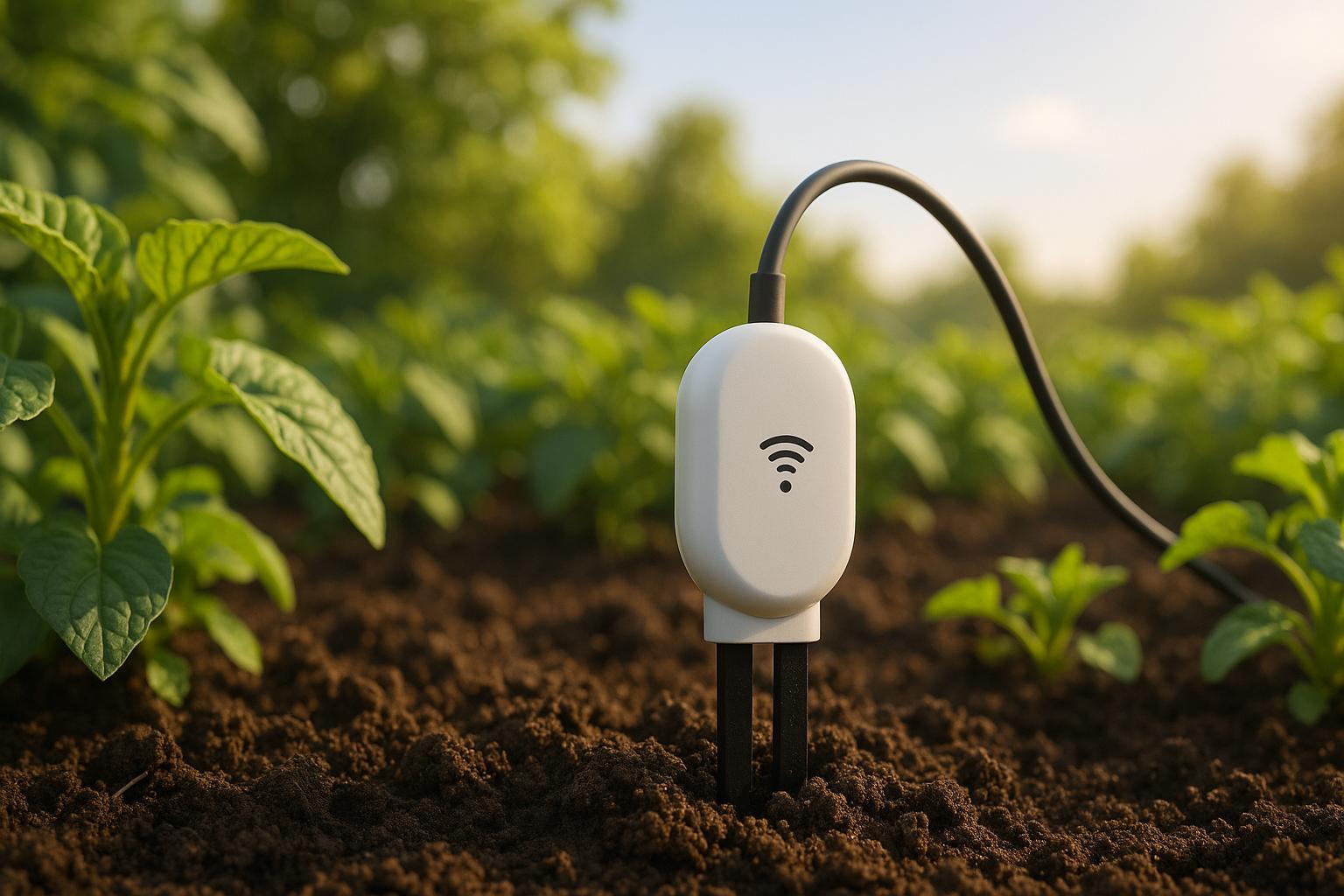
How Soil Sensors Work with Cloud Irrigation
Explore how soil sensors and cloud irrigation systems optimize water usage, enhance plant health, and simplify garden management.
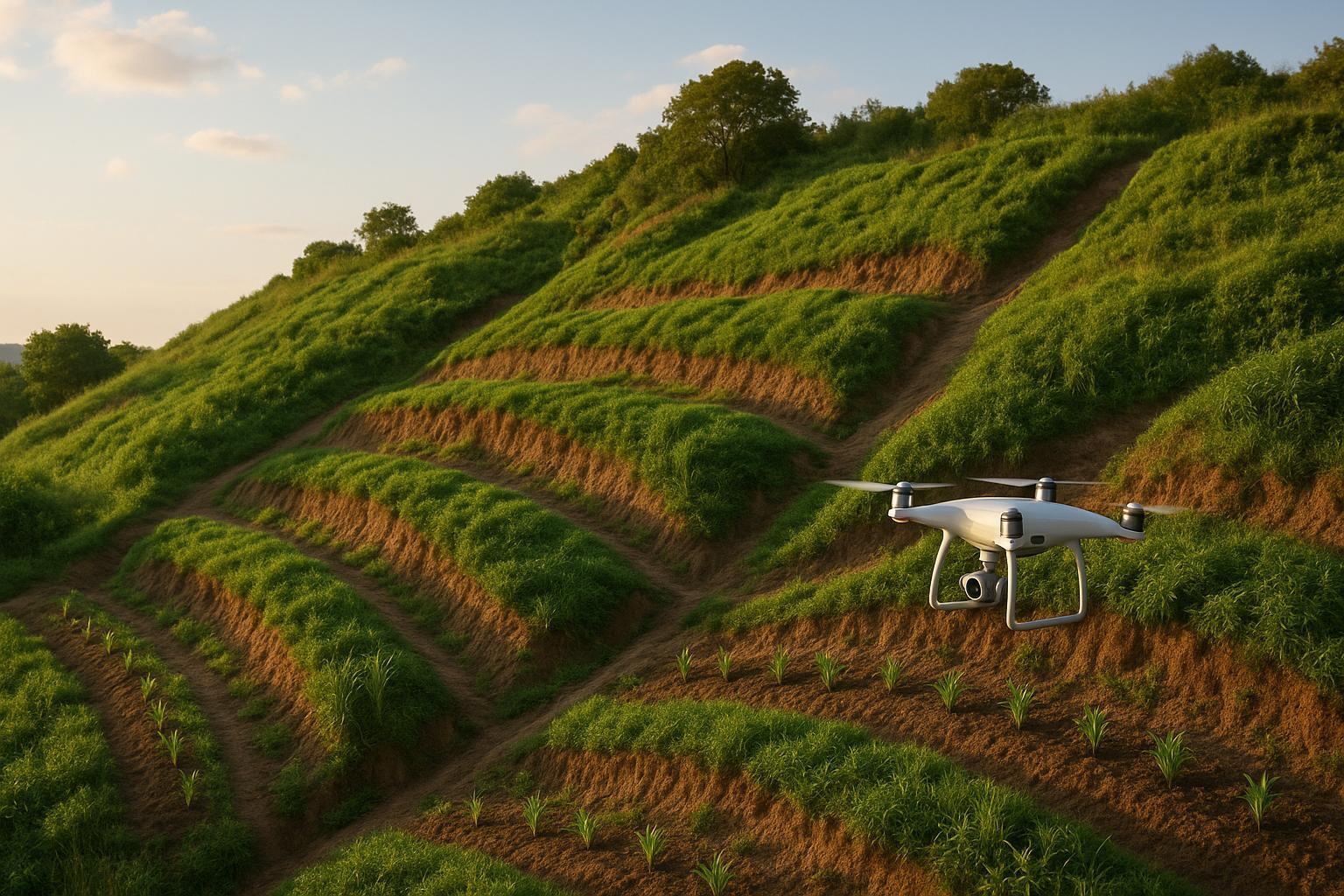
AI Tools for Soil Erosion Control
Explore how AI tools are revolutionizing soil erosion control with real-time monitoring, mapping, and tailored strategies for effective land management.
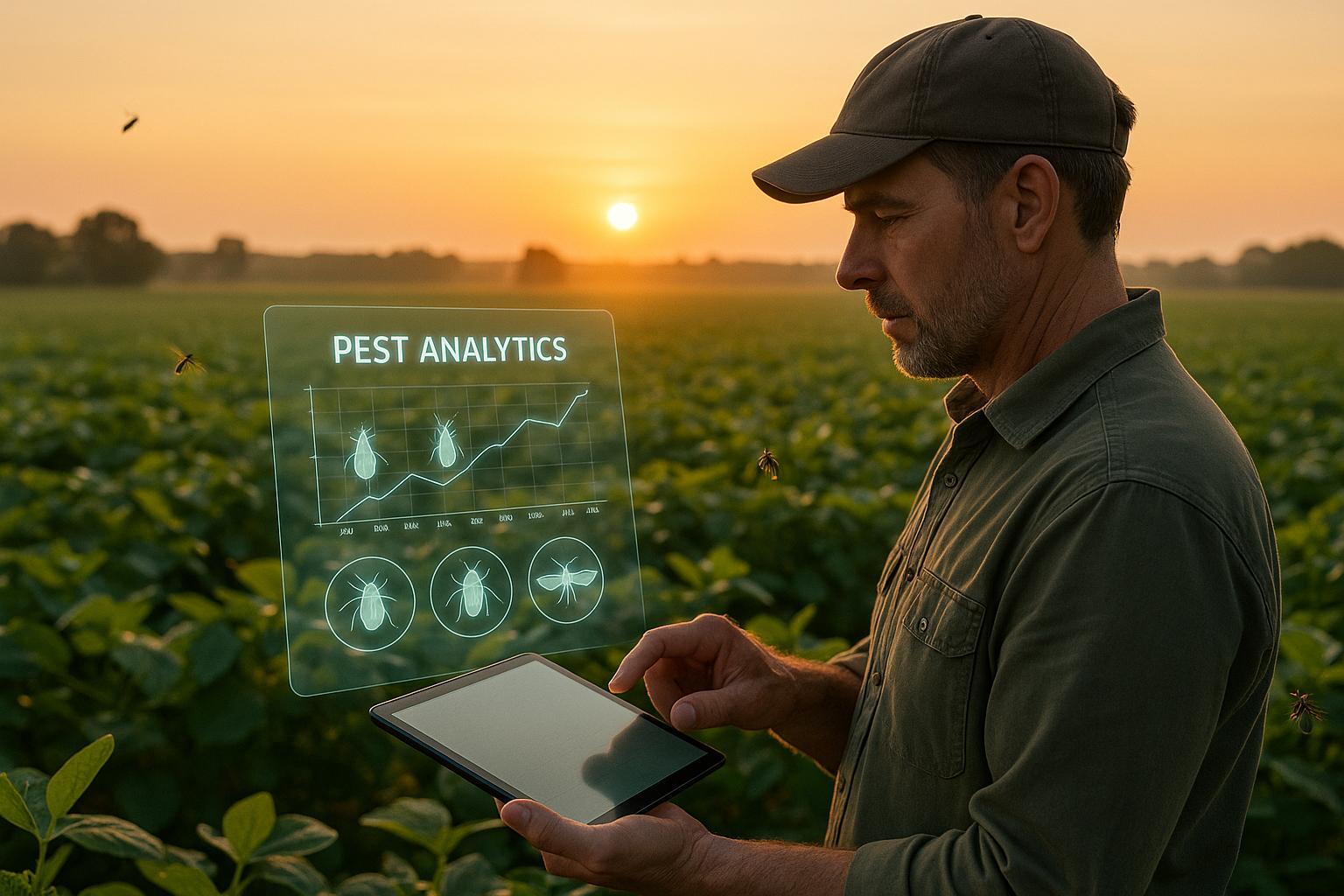
Real-Time Pest Analytics for Seasonal Yields
Explore how real-time pest analytics revolutionizes farming by enhancing yields, reducing pesticide use, and promoting sustainable practices.
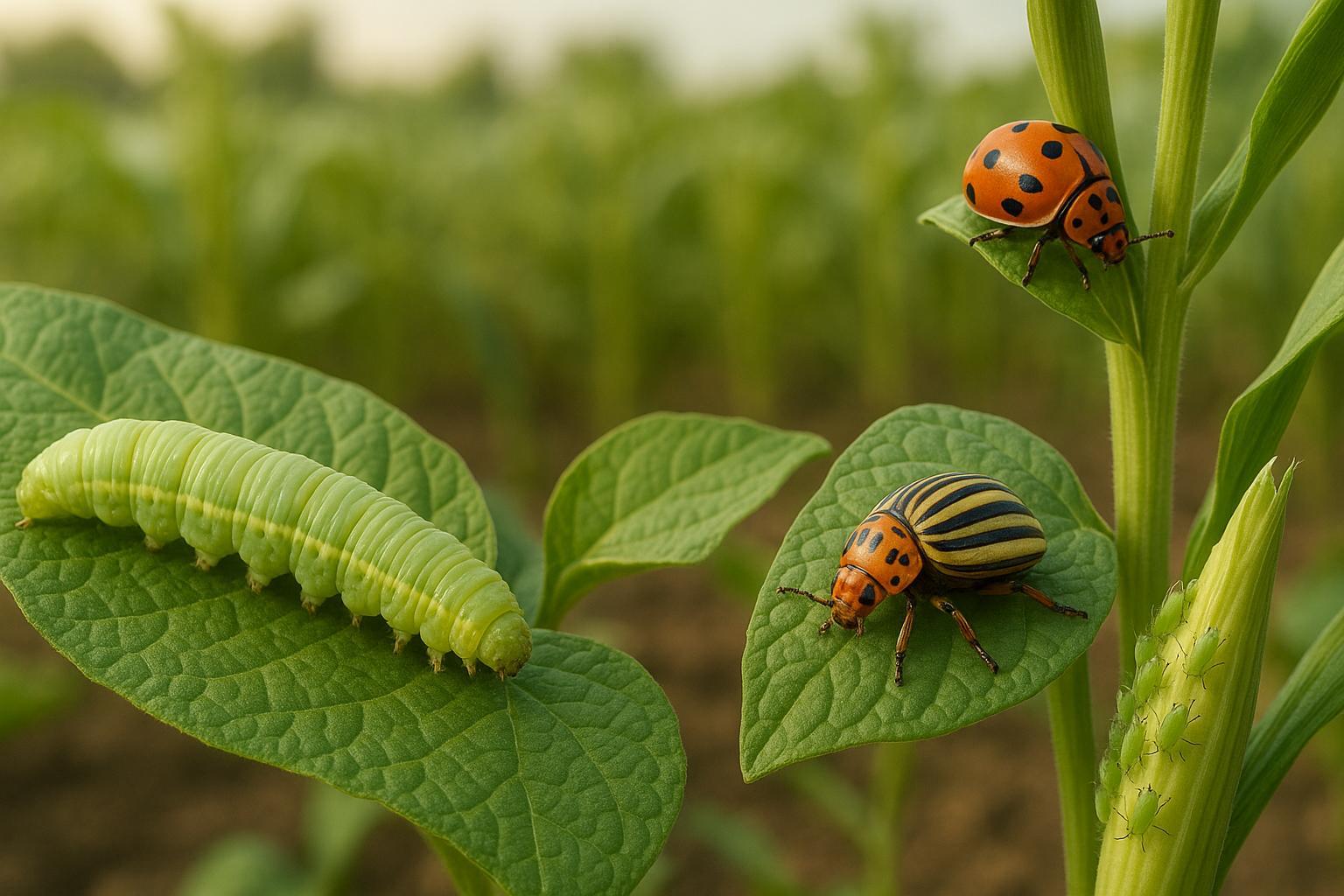
Best Free Pest Recognition Datasets Online
Explore the best free datasets for pest recognition that enhance AI tools for effective and sustainable pest management in agriculture and gardening.
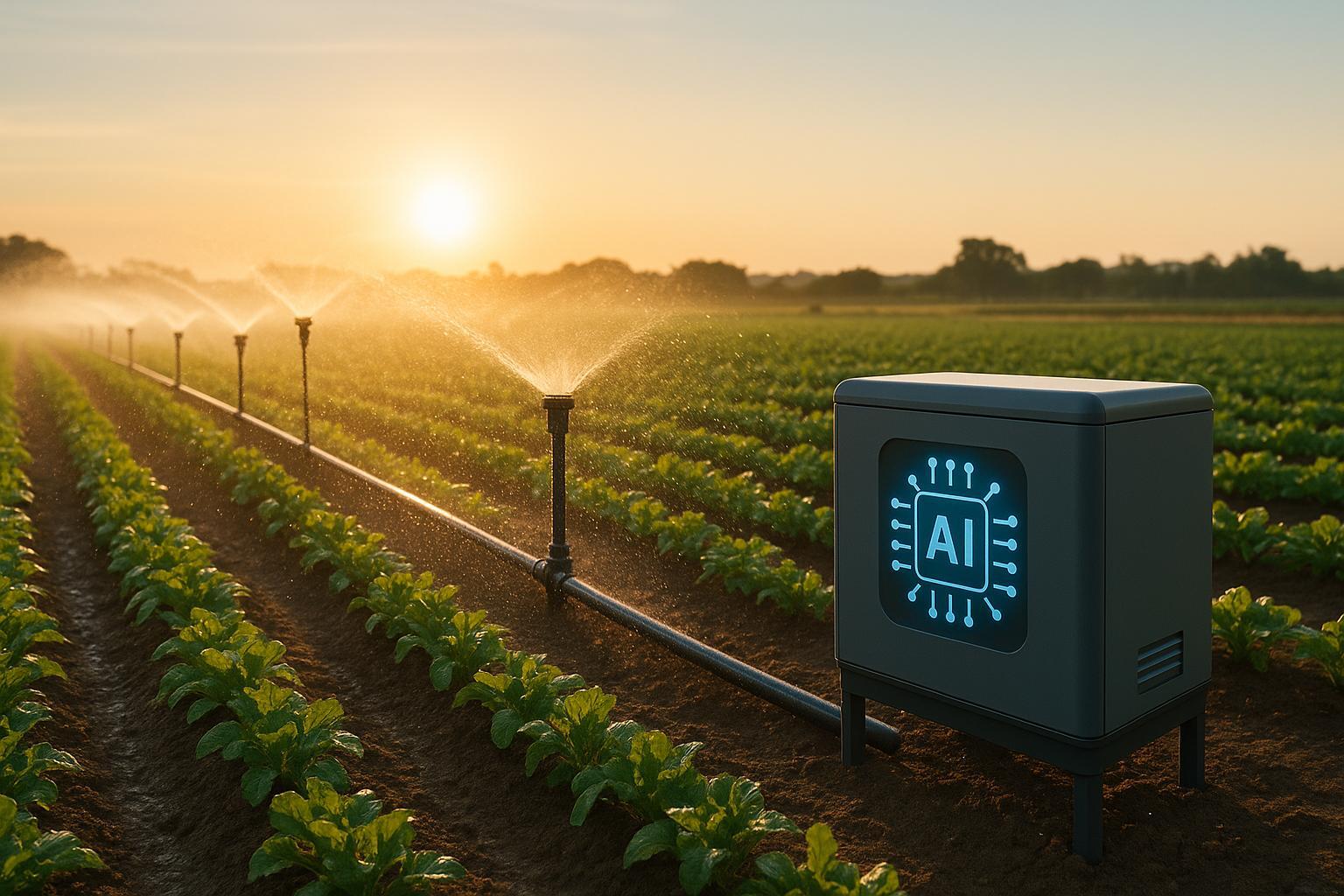
5 Common Irrigation Problems AI Solves
AI-powered irrigation systems tackle common issues like water waste and uneven distribution, promoting healthier plants and reducing costs.

The Ultimate Guide to U-Shaped Garden Planting: Planning, Design, and Maintenance Tips
Transform your outdoor space with a U-shaped garden! Learn how to plan, design, and maintain your garden with our comprehensive guide. Discover the benefits of U-shaped garden design and the best plants for your garden.